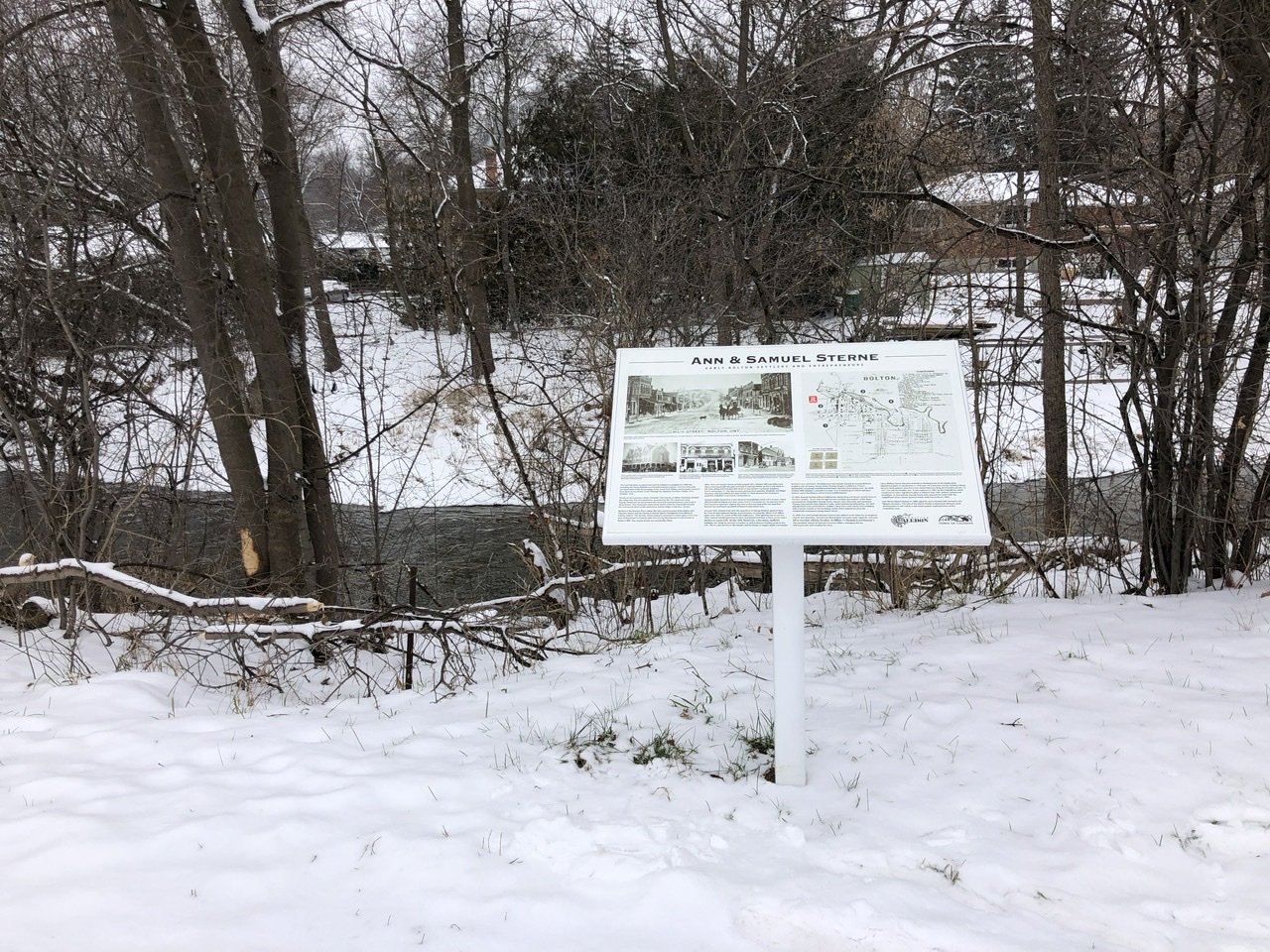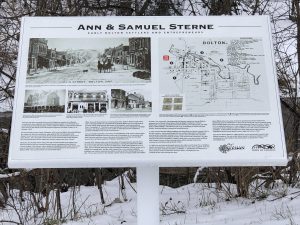JSC thanks the Albion Bolton Historical Society for the following submission:
In May 2021, a heritage plaque honouring Ann and Samuel Sterne was installed by the Town of Caledon. The plaque outlines Ann and Samuel’s contribution to early commercial development in the northwest quadrant of Bolton’s downtown core. They were similar in age to George Bolton, arriving in Bolton’s Mill about 10 years after George purchased 200 acres and built the grist mill.
The plaque, a combined effort by Town staff and Albion Bolton Historical Society members, is located on the south side of the Humber River, beside the path that runs between the Bolton Heritage kiosk on Queen Street North and Ann Street.
While this new interpretive plaque has been unveiled during Bolton’s Bicentennial year, it was put into work several years ago to coincide with the naming of the adjacent Ann and Samuel Sterne parking lot. Regrettably, Covid-19 guidelines precluded having a public unveiling event.
The full text of the plaque reads as follows:
Ann and Samuel Sterne Early Bolton Settlers and Entrepreneurs
This land has been occupied and used by Indigenous peoples for millennia, including the Huron-Wendat and the Haudenosaunee peoples. It is the treaty and territorial land of the Mississaugas of the Credit First Nation having been acquired from them by the British Crown through the Ajetance Purchase (Treaty 19) in October, 1818.
Provincial land surveyor James Chewett’s 1819 survey of Albion Township divided the valley into 200-acre quadrants, separated by the 7th Concession Line (Queen Street) and an unsurveyed dirt track that evolved between Lots 8 and 9 (now King Street). The crossroads where these streets intersect eventually became the commercial heart of the settlement, known today as the ‘four corners’.
Nestled in the Humber River valley, this site commemorates early settlers Ann Plummer Sterne and her husband Samuel Sterne, immigrants from Wexford County, Ireland. The Sternes, whose property extended on both sides of the river, were instrumental in shaping early commercial development in the hamlet of ‘Bolton’s Mill’. Two nearby street are named after them.
When Ann and Samuel Sterne arrived around 1831, Bolton’s Mill was little more than a clearing beside the grist mill built by George Bolton on the south bank of the river along what became Mill Street in the hamlet’s northeast quadrant (Lot 9, Concession 7). The Sternes were joining Ann’s parents, Elizabeth and Ralph Plummer, who had settled ten years earlier on what became the southwest quadrant of Bolton’s core (Lot 8, Concession 6).
Samuel initially leased the Crown Reserve immediately north of his in-laws, which offered fertile farmland and river access (Lot 9, Concession 6). He and Ann built their log home and barn close to the river at the east end of the lot, land that became the northwest quadrant of Bolton’s downtown core.
Around 1833, Samuel took over the operation of George Bolton’s general store. By 1834, he had replaced George as postmaster, running the Albion Post Office, open since 1832, for seven of the next eight years. After gaining title to Lot 9 in 1835, Samuel started planning his own commercial interests: a store, an inn and a distillery to supply both.
By late 1839, Sterne’s Inn, a two-storey, mudbrick building, was ready to welcome travellers as well as farmers hauling grain to the mill. The inn was the first in the hamlet and its cluster of wagon sheds and stables formed a rear courtyard. Development had already started on George Bolton’s property east of Queen Street where Thomas Rogers’ smithy/inn, Francis McDonald’s cooperage and Richard Paxman’s tannery were taking root. By 1840, Bolton’s Mill also included a schoolhouse and entailed 14 or 15 buildings, of which half were houses, some of which doubled as commercial establishments.
In 1843, Samuel started selling building lots close to the four corners. Some were bought by non-resident speculators, while those purchased by shoemaker George Evans, weaver John Donnelly and carpenter Thomas Hainsworth were typical of early, rural commercial enterprises. By 1847, George Evans had converted his cobbler’s shop into a two-storey brick building with a tavern, known as the Exchange Hotel, which quickly became the commercial centrepiece along Queen Street.
In 1848, Ann and Samuel donated land on the valley’s north slope for an Anglican church and cemetery. Samuel was buried there two years later, aged 46. Ann was left to raise their children: Dorothea 16, William 11, Elizabeth 8 and Plummer 5. She assumed control of Samuel’s business affairs, managing the inn (closing its bar) and running the store.
Later, William Sterne became involved in the development of the family land, registering plans of subdivision in 1870 and 1875 that laid out the existing village lot and street pattern west from Ann Street between King and Foundry streets. In 1871, he sold the family’s inn. It was replaced in 1881 by the Doig Block which continues to hold a significant place in Bolton’s late 19thcentury commercial streetface. In that period, George Evans also replaced his hotel with the magnificent three-storey Queen’s Hotel, sadly lost to fire in 1969.
Ann Sterne died in Bolton in 1888, aged 83, and is buried with Samuel in the hillside cemetery. The role of the Sterne family in downtown Bolton’s early development is still visible in the street pattern and built form of this immediate area.
The post New Bolton Heritage Plaque Honours Ann and Samuel Sterne appeared first on Just Sayin' Caledon.



